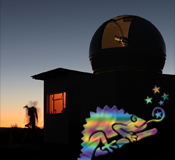 |
CHAMÄLEON + ONJALA OBSERVATORY DeepSky | SITEMAP HOME CHAMÄLEON |
|
 |
|||
| « zurück zur Startseite
Nebulae « back to home nebulae |
Großes Bild laden - load large image 2048
x 1400 Pixel Aufnahmedaten Image data |
NGC 1999 (the keyhole nebula) and Herbig Haro objects in the constellation Orion

Unser Bild zeigt eine sehr staubige Region, direkt südlich des großen Orionnebels von etwa 1 x 1.5 Grad Größe. Dort befindet sich ein Teil des Orion Molekühlwolkenkomplex - eine Region intensiver Sternentstehung in der sich auch viele Herbig Haro (HH) Objekte befinden.
NGC 1999, auch als Schlüssellochnebel bezeichnet, liegt in unserer Aufnahme rechts oberhalb der Bildmitte. Es ist eines der interessanten Objekte im Bild. Es ist ein Reflexionsnebel der vom Stern V380 Oriones beleuchtet wird. Die dunkle Stelle in der Mitte ist annähernd materiefrei und seine Entstehung ist bislang ungeklärt. Links unten im Bild weitere, sehr schwache Reflexionsnebel, die vom Stern 49 Oriones beleuchtet werden.
Besonders interessant sind die zahlreichen Herbig Haro Objekte in dieser Region. Es sind Sternsysteme in ihrer Entstehung, zum großen Teil sind die Sterne noch gar nicht sichtbar, sondern noch von ihrem Kokon aus Staub und Gas umgeben, obwohl die Kernfusion bereits gezündet hat. Die Astronomen beobachten mit ihren Infrarotteleskopen also sozusagen Sterne im "Kreissaal". Auffällig prominent ist HH 34. Es ist die südliche Bugstoßfront des HH 34 Systems bei dem ein vom Stern ausgehender Jet mit einer Geschwindigkeit von mehreren hundert Kilometer pro Sekunde auf das interstellare Medium trifft. Diese Jets sind bipolar, von der nördlichen Stoßfront ist auf unserem Bild leider nichts zu sehen. Die Sterne sind erst wenige Millionen Jahre alt. Den Herbig Haro Objekten ist nur eine kurze Lebenszeit von etwa 100.000 Jahren vergönnt, dann haben die Sterne ihre Umgebung frei geräumt.
Die Objektklasse ist nach den Astronomen George Herbig und Guillermo Haro benannt, die derzeitige Objekte in den 1940er Jahren erstmalig intensiv erforscht haben.
Object description:
Our image shows a very dusty region, directly south of the large Orion Nebula of about 1 x 1.5 degrees size. There is a part of the Orion Molecular Cloud Complex - a region of intense star formation where also many Herbig Haro (HH) objects are located.
NGC 1999, also known as the Key Nebula, lies to the right above the centre of the image in our photograph. It is one of the interesting objects in the image. It is a reflection nebula illuminated by the star V380 Oriones. The dark spot in the middle is almost free of matter and its formation is still unexplained. In the lower left of the image, there are other very faint reflection nebulae illuminated by the star 49 Oriones.
The numerous Herbig Haro objects in this region are particularly interesting. These are star systems in their formation, for the most part the stars are not even visible yet, but still surrounded by their cocoon of dust and gas, although nuclear fusion has already ignited. With their infrared telescopes, astronomers are thus observing stars in the "circle room", so to speak.
Particularly prominent is HH 34, the southern bow shock front of the HH 34 system, where a jet emanating from the star hits the interstellar medium at a speed of several hundred kilometres per second. These jets are bipolar, unfortunately nothing of the northern shock front can be seen in our image. The stars are only a few million years old. The Herbig Haro objects only have a short lifetime of about 100,000 years, after which the stars have cleared their surroundings.
The object class is named after the astronomers George Herbig and Guillermo Haro, who first intensively studied these objects in the 1940s.
 |
 |
 |
| NGC
1999 - der "Schlüssellochnabel und die Herbig Haro Objekte HH 1 + HH 2 |
Der
Stern 49 Ori, IC 430 und weitere Herbig Haro Protosterne |
Die
Herbig Haro Objekte HH 222, HH 34 und HH 401 |
 |
Eine
Aufnahme des Weltraumteleskops Hubble
sehen Sie hier. You can see an image from the Hubble Space Telescope here. « Hier oder auf das Vorschaubild zum Laden eines großen Bildes mit Objektbezeichnungen klicken. « Click here or on the thumbnail to load a large image with object annotations. |
NGC 1999 and Herbig Haro objects in the constellation Orion
Image data
27.03 + 02.04.2022 — 24 x 600, ZWO ASI 071 MC Pro
Telescope: Astro Physics 130 mm EDFS with field flattener at f = 850 mm
Location: Chamäleon Observatory, Onjala Lodge, Namibia
Image processing: DeepSkyStacker, Pixinsight and Photoshop
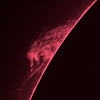 |
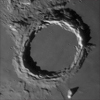 |
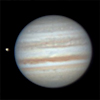 |
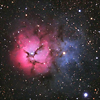 |
 |
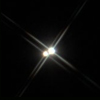 |
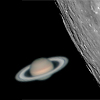 |
| Sonne | Mond | Sonnensystem | DeepSky | Weitwinkel | Verschiedenes | Spez. Projekte |